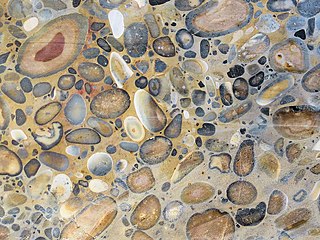 W
WConglomerate is a clastic sedimentary rock that is composed of a substantial fraction of rounded to subangular gravel-size clasts. A conglomerate typically contain a matrix of finer grained sediments, such as sand, silt, or clay, which fills the interstices between the clasts. The clasts and matrix are typically cemented by calcium carbonate, iron oxide, silica, or hardened clay.
 W
WThe Guavio Formation is a geological formation of the Altiplano Cundiboyacense, Eastern Ranges of the Colombian Andes. The formation consists of conglomerates, shales and limestones, dates to the Late Jurassic and Early Cretaceous periods; Tithonian to Berriasian epochs and has a maximum thickness of 1,000 metres (3,300 ft).
 W
WHertfordshire puddingstone is a conglomerate sedimentary rock composed of rounded flint pebbles cemented together by a younger matrix of silica quartz. The distinctive rock is largely confined to the English county of Hertfordshire but small amounts occur throughout the London Basin. Despite a superficial similarity to concrete, it is an entirely natural silcrete. A fracture runs across both the pebbles and the sandy matrix as both have equal strength unlike concrete where the pebbles remain whole and a fracture occurs only in the matrix. Like other puddingstones, it derives its name from the manner in which the embedded flints resemble the plums in a pudding. It forms the local base of the Upnor Formation of the Lambeth Group.
 W
WJasper conglomerate is an informal term for a very distinctive Paleoproterozoic quartz and jasper pebble conglomerate that occurs within the middle part of the Lorrain Formation of the Cobalt Group of the Huronian Supergroup. It is also known by other names including pebble jasper conglomerate, St. Joseph Island puddingstone, Drummond Island puddingstone, Michigan puddingstone. The jasper conglomerate occurs on St. Joseph Island and the St. Mary's River area north and northwest of the Bruce Mines of Northern Ontario, about 65 kilometres (40 mi) east of Sault Ste. Marie. This conglomerate consisted originally of gravelly sands and sandy gravels composed of subrounded pebbles of red jasper, white quartzite, semi-transparent quartz, and black chert, with coarse-grained sand matrix. Typically it contains between about 30% to as much as 90% pebbles. It has been cemented and partially metamorphosed into a quartzitic conglomerate. The beds of jasper conglomerates fill erosional troughs and channels of what are interpreted to be either alluvial fan or braided river deposits of the Lorrain Formation. These deposits are interpreted to represent nonglacial deposits that immediately postdate the Makganyene glaciation.
 W
WMetaconglomerate is a rock type which originated from conglomerate after undergoing metamorphism. Conglomerate is easily identifiable by the pebbles or larger clasts in a matrix of sand, silt, or clay. Metaconglomerate looks similar to conglomerate, although sometimes the clasts are deformed. The cement matrix of conglomerate is not as durable as the grains, and hence when broken, conglomerate breaks around the grains. Metaconglomerate, however, breaks through the grains, as the cement has recrystallized and may be as durable as the clasts.
 W
WPuddingstone, also known as either pudding stone or plum-pudding stone, is a popular name applied to a conglomerate that consists of distinctly rounded pebbles whose colours contrast sharply with the colour of the finer-grained, often sandy, matrix or cement surrounding them. The rounded pebbles and the sharp contrast in colour gives this type of conglomerate the appearance of a raisin or Christmas pudding. There are different types of puddingstone, with different composition, origin, and geographical distribution. Examples of different types of puddingstones include the Hertfordshire, Schunemunk, Roxbury, and St. Joseph Island puddingstones.
 W
WRiver gravel is a name given to gravel composed of small pieces of rounded stone of various colors, usually no larger than a large coin. It is named for the effect of many years of rounding of the edges of the stones due to a flow of water over it, as often takes place in a river. River gravel is often used in outdoor settings, such as a park walkway.